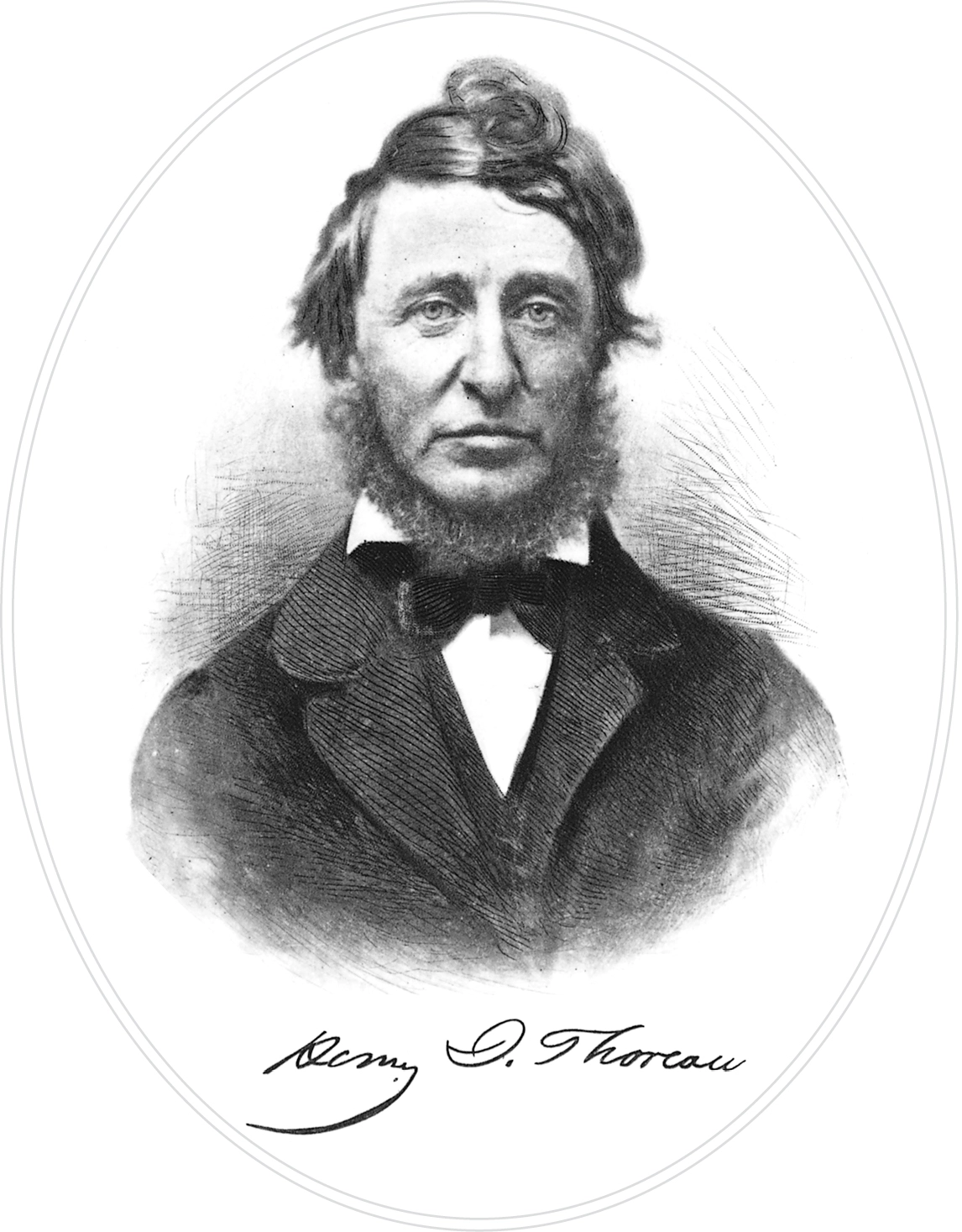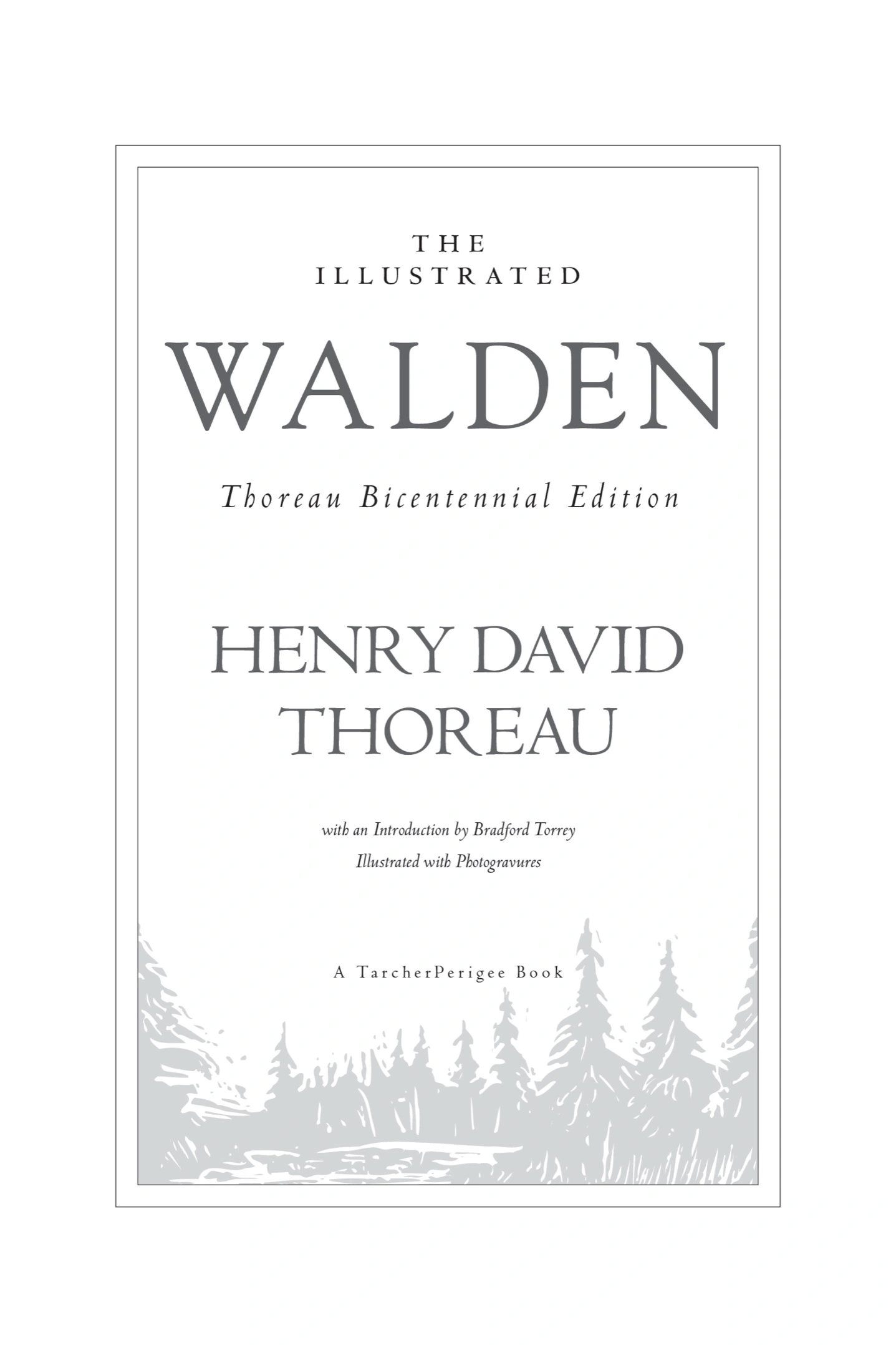The Illustrated Walden
PUBLISHERS’ NOTE
In 1897, with the friendly assistance of Mr. A. W. Hosmer, of Concord, Mass., who supplied photographs for nearly all the illustrations, the publishers issued a Holiday Edition of Walden in two volumes, illustrated with photogravures. The present edition is a reissue of that of 1897, with only such changes as were necessary to bring the whole work into a single convenient volume.
BOSTON, September, 1902.

Thoreau in 1855


An imprint of Penguin Random House LLC
375 Hudson Street
New York, New York 10014
The Illustrated Walden was originally published in 1897 as a two-volume “Holiday Edition” of Walden, and republished in 1902 as a single volume.
First TarcherPerigee edition published 2016.
Tarcher and Perigee are registered trademarks, and the colophon is a trademark of Random House LLC
eBook ISBN 9781101993262
Title page illustration: Ron and Joe/Shutterstock
Cover design: Alison Forner
Cover art: Based on wood engravings by Ethelbert White, originally published in Walden by Henry David Thoreau, Penguin Books, 1938
Version_1
Contents
Publishers’ Note
Title Page
Copyright
List of Illustrations
Introduction by Bradford Torrey
I. Economy
II. Where I Lived, and What I Lived For
III. Reading
IV. Sounds
V. Solitude
VI. Visitors
VII. The Bean-Field
VIII. The Village
IX. The Ponds
X. Baker Farm
XI. Higher Laws
XII. Brute Neighbors
XIII. House-Warming
XIV. Former Inhabitants, and Winter Visitors
XV. Winter Animals
XVI. The Pond in Winter
XVII. Spring
XVIII. Conclusion
Index
List of Illustrations
HENRY D. THOREAU, FROM THE DAGUERREOTYPE TAKEN BY MOXHAM OF WORCESTER IN 1855 OR 1856.
THE HOUSE AT WALDEN, FROM A DRAWING BY CHARLES COPELAND, VIGNETTE ON ENGRAVED TITLE-PAGE.
THOREAU’S BIRTHPLACE
“Born in the Minott house on the Virginia Road, where Father occupied Grandmother’s ‘thirds,’ carrying on the farm. . . . Lived there about eight months.” —Thoreau’s Journal, Dec. 27, 1855.
CONCORD RIVER FROM NASHAWTUC HILL
“The Musketaquid, or Grass-ground River, though probably as old as the Nile or Euphrates, did not begin to have a place in civilized history until the fame of its grassy meadows and its fish attracted settlers out of England in 1635, when it received the other but kindred name of Concord from the first plantation on its banks. . . . To an extinct race it was grass-ground, where they hunted and fished; and it is still perennial grass-ground to Concord farmers, who own the Great Meadows, and get the hay from year to year.”
—A Week on the Concord and Merrimack Rivers.
A. BRONSON ALCOTT
The axe with which Thoreau cleared the ground for his house at Walden was borrowed from Mr. Alcott.
SITE OF THE HOUSE AT WALDEN FROM THE POND
RALPH WALDO EMERSON
Mr. Emerson owned the land on which the Walden house stood. In a letter to him, January 24, 1843, Thoreau wrote: “I have been your pensioner for nearly two years, and still left free as under the sky. It has been as free a gift as the sun or the summer, though I have sometimes molested you with my mean acceptance of it,—I who have failed to render even those slight services of the hand which would have been for a sign at least; and, by the fault of my nature, have failed of many better and higher services. But I will not trouble you with this, but for once thank you as well as Heaven.”
EMERSON’S HOUSE
With profile figure of Mr. Emerson.
FURNITURE USED IN THE WALDEN HOUSE
HENRY D. THOREAU IN 1854, FROM THE ROWSE CRAYON IN THE CONCORD PUBLIC LIBRARY
WALDEN FROM THE HOUSE
The cairn of stones at the left marks approximately the site of the house.
THE OLD MARLBOROUGH ROAD
“If with fancy unfurled
You leave your abode,
You may go round the world
By the Old Marlborough Road.”
—Thoreau, in Excursions.
NATHANIEL HAWTHORNE
In the American Note-Books Hawthorne thus records his feeling toward Thoreau: “He is one of the few persons, I think, with whom to hold intercourse is like hearing the wind among the boughs of a forest-tree; and, with all this wild freedom, there is high and classic cultivation in him too.”
PLEASANT MEADOW
“An adjunct of the Baker Farm,” where Thoreau thought of living before he went to Walden.
PINES SET OUT BY THOREAU ON HIS BEANFIELD
HENRY D. THOREAU, from the ambrotype taken by Dunshee of New Bedford, August 19, 1861
SAMUEL STAPLES
Thoreau’s jailer when he was arrested for refusing to pay taxes.
THOREAU’S FLUTE, SPY-GLASS, AND COPY OF WILSON’S ORNITHOLOGY
“Then from the flute, untouched by hands,
There came a low, harmonious breath:
‘For such as he there is no death; —
His life the eternal life commands;
Above man’s aims his nature rose:
The wisdom of a just content
Made one small spot a continent,
And tuned to poetry Life’s prose.’”
—Louisa M. Alcott.
WALDEN POND, SHOWING THE SAND BAR
WHITE POND
BAKER FARM
HENRY D. THOREAU IN 1861, FROM THE MEDALLION BY W. RICKETSON
BRISTER’S SPRING
GREAT MEADOWS
“We . . . floated . . . into the Great Meadows, which, like a broad moccasin print, have leveled a fertile and juicy place in nature.”
—A Week on the Concord and Merrimack Rivers.
(The horseman in the foreground is the sculptor, Daniel C. French.)
CONCORD FROM BRISTER’S HILL
EDMUND HOSMER
The picture below the portrait is a view of the Hosmer house.
WALDEN IN WINTER
SURVEY OF WALDEN POND
GEORGE WILLIAM CURTIS
Those who helped Thoreau raise his house at Walden were Emerson, Alcott, Edmund Hosmer and his three sons John, Edmund, and Andrew, George William Curtis, and Sherman Tuttle,—“the younger men for the liftings, the elders for advice.”
THOREAU’S HOUSE, MAIN STREET, CONCORD, IN WHICH HE DIED
Introduction
T he world likes eccentric people. Not that it wishes to like them; it would feel very differently about them if it could; its prejudices are all in favor of conformity; but the world is never its own master. A worshiper of routine and precedent, it has, nevertheless, a natural relish for variety, and is diverted, like a child, at the sight of something unexpected and out of the common. Its wisdom is prudence. Its rule of life is to keep on the safe side. Follow the path, it says; take no risks.
1 comment